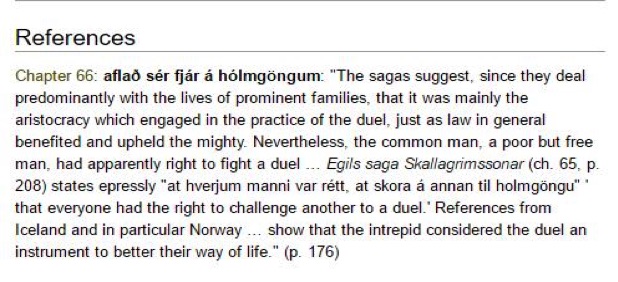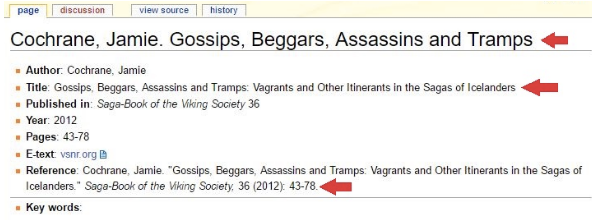Help:Contents: Difference between revisions
No edit summary |
No edit summary |
||
| Line 110: | Line 110: | ||
===Filling a new page=== | |||
Where to find the model? | '''Where to find the model?''' | ||
In the menu on the left, select “All entries”. | * '''1.''' In the menu on the left, select “All entries”. | ||
* '''2.''' There you will find the page “Template - article”. [[File:template.png]] | |||
Open it, and select “edit” on the top of the page | * '''3.''' Open it, and select “edit” on the top of the page | ||
Or you can copy-past the model from here: | Or you can copy-past the model from here: | ||
Revision as of 13:26, 19 August 2016
Here you can find some basic information in how to write a Wikisaga entry
MLA reference system
Every summary should be accompanied by a full MLA reference.
Books
One author
Lastname, Firstname. Title of Book. City of Publication: Publisher, Year of Publication. Medium of Publication.
Example: Gleick, James. Chaos: Making a New Science. New York: Penguin, 1987. Print.
NB Authors with two names (e. g. Jesse L. Byock) → two dots: Byock, Jesse L..
More than one author
Last name, First name, and First name Last name. Title of Book. City of Publication: Publisher, Year of Publication. Medium of Publication.
Example: Gillespie, Paula, and Neal Lerner. The Allyn and Bacon Guide to Peer Tutoring. Boston: Allyn, 2000. Print.
Article in a book
Lastname, First name. "Title of Essay." Title of Collection. Pages. Ed. Editor's Name(s). City of Publication: Publisher, Year. Medium of Publication.
Example: De Looze, Laurence. "The Concept of the Self in Egil's Saga: A Ricoeurean Approach." Egil, The Viking Poet: New Approaches to Egil's Saga, pp. 57-74. Eds. Laurence De Looze, Jón Karl Helgason, Russell Poole, Torfi H. Tulinius. Toronto: University of Toronto Press, 2015.
An edition of a book
A Subsequent Edition
Cite the book as you normally would, but add the number of the edition after the title.
Example: Crowley, Sharon, and Debra Hawhee. Ancient Rhetorics for Contemporary Students. 3rd ed. New York: Pearson/Longman, 2004. Print.
A Work Prepared by an Editor/translation
Cite the book as you normally would, but add the editor/translator after the title.
Example: Bronte, Charlotte. Jane Eyre. Ed. Margaret Smith. Oxford: Oxford UP, 1998. Print.
Article in a book part of a serie of books
Last name, First name. Title of Book. Name of series. City of Publication: Publisher, Year of Publication. Medium of Publication.
Example: Jón Hnefill Aðalsteinsson. Trúarhugmyndir í Sonatorreki. Studia Islandica 57. Reykjavík : Bókmenntafræðistofnun Háskóla Íslands : Háskólaútgáfan, 2001.
Introduction, Preface, Foreword, or Afterword:
When citing an introduction, a preface, a foreword, or an afterword, write the name of the author(s) of the piece you are citing. Then give the name of the part being cited, which should not be italicized or enclosed in quotation marks; in italics, provide the name of the work and the name of the author of the introduction/preface/forward/afterward. Finish the citation with the details of publication, page range, and item type.
Example: Farrell, Thomas B. Introduction. Norms of Rhetorical Culture. By Farrell. New Haven: Yale UP, 1993. 1-13. Print.
Articles
Article in a Magazine:
Author(s). "Title of Article." Title of Periodical Day Month Year: pages. Medium of publication.
Example: Buchman, Dana. "A Special Education." Good Housekeeping Mar. 2006: 143-48. Print.
Article in a Newspaper
Cite a newspaper article as you would a magazine article, but note the different pagination in a newspaper. If there is more than one edition available for that date (as in an early and late edition of a newspaper), identify the edition following the date (e.g., 17 May 1987, late ed.).
Example: Krugman, Andrew. "Fear of Eating." New York Times 21 May 2007 late ed.: A1. Print.
An Article in a Scholarly Journal
Author(s). "Title of Article." Title of Journal Volume.Issue (Year): pages. Medium of publication.
Example: Bagchi, Alaknanda. "Conflicting Nationalisms: The Voice of the Subaltern in Mahasweta Devi's Bashai Tudu." Tulsa Studies in Women's Literature 15.1 (1996): 41-50. Print.
NB: Always provide issue numbers, when available.
NB: We do not mention the editors - so we can erase the line ‘editors’ in the upper part of wiki-page.
An Article in a Special Issue of a Scholarly Journal
Author(s). "Title of Article." Title of Journal. Spec. issue of Title of Journarl Volume.Issue (Year): pages. Medium of publication.
Example: Burgess, Anthony. “Politics in the Novels of Graham Greene.” Literature and Society. Spec. issue of Journal of Contemporary History 2.2 (1967): 93-99. Print.
Other
A Review
NB: Usually we do not site reviews, but if necessary follow these instructions:
To cite a review, include the title of the review (if available), then the abbreviation "Rev. of" for Review of and provide the title of the work (in italics for books, plays, and films; in quotation marks for articles, poems, and short stories). Finally, provide performance and/or publication information.
Review Author. "Title of Review (if there is one)." Rev. of Performance Title, by Author/Director/Artist. Title of Periodicalday month year: page. Medium of publication.
Example: Seitz, Matt Zoller. "Life in the Sprawling Suburbs, If You Can Really Call It Living." Rev. of Radiant City, dir. Gary Burns and Jim Brown. New York Times 30 May 2007 late ed.: E1. Print.
Dissertations
Dissertations may be used as sources whether published or not. Cite the work as you would a book, but include the designation Diss. followed by the degree-granting school and the year the degree was awarded.
A published dissertation:
Italicize the title and include the publication date. You may also include the University Microfilms International (UMI) order number if you choose:
Example: Bishop, Karen Lynn. Documenting Institutional Identity: Strategic Writing in the IUPUI Comprehensive Campaign. Diss. Purdue University, 2002. Ann Arbor: UMI, 2004. Print.
Not published:
The title of the theses is in quotation marks and the reference ends with the date the degree was awarded.
Example: Graban, Tarez Samra. "Towards a Feminine Ironic: Understanding Irony in the Oppositional Discourse of Women from the Early Modern and Modern Periods." Diss. Purdue University, 2006. Print.
NB: We do not use Master Theses as source material.
Instructions for the summary
- Summaries should be 150-250 words long.
- If the article’s main theme isn’t Njála or Egla, a brief mention of the article’s use of them should be made in the summary.
Instructions for the ‘references’ section
- The quotation from the article should be 1 to 3 sentence(s) long, and should illustrate either the article’s main arguments or its use of the saga.
- Each article should have 1 to 4 quotations.
- If relevant, a passage can be omitted and replaced by three dots, as in:

When searching for the appropriate saga-passage
- You can use the search option on the website Sagadb if you have a passage from the saga, but aren’t sure of the chapter in which it appears.
- The saga-passage can be one word to one (short) sentence long.
- On the article page, the saga-passage will be quoted in Icelandic, independently of the language of the article.
- The article-quote shouldn’t be translated. It will be written in the original language.
Webpage-technical-information
Create a new page
- To create a new page, the easiest is to use the search tool. Write: Last Name, First Name. Title of the article
- NB Name:
- For Icelandic scholars: First Name Patronym. Title of the article (e.g.: Arnór Sigurjónsson. Arghyrnu lát árna)
- Scholars with two Names: Either write both in full letters (e.g.: Miller, William Ian.) or use two dots after the abbreviated name (e.g.: Byock, Jesse L..)
- NB Title:For the sake of consistency of the wikisaga website, use the word-initial capital letters, even if the edition of the article doesn’t use them.
- If the title is long, or in two parts, you can use only the first part for the title of the page.
- E.g.: ‘Gossips, Beggars, Assassins and Tramps’ instead of ‘Gossips, Beggars, Assassins and Tramps: Vagrants and Other Itinerants in the Sagas of Icelanders’.
- If the title is long, or in two parts, you can use only the first part for the title of the page.
- NB Don’t forget however to put the complete title in both the description and MLA reference (see example below).
Filling a new page
Where to find the model?
- 1. In the menu on the left, select “All entries”.
- 2. There you will find the page “Template - article”.

- 3. Open it, and select “edit” on the top of the page
Or you can copy-past the model from here:
- Author:
- Title:
- Published in:
- Editors:
- Place, Publisher:
- Year:
- Pages:
- E-text:
- Reference: MLA
- Key words:
Annotation
Text missing
Lýsing
Texta vantar
See also
References
Links
- Written by:
- Icelandic/English translation:
NB: In the upper-part, erase the lines that are irrelevant (e.g. Editors for Journal articles) For references: indicate n/a (‘not applicable/available’, meaning that you worked on it, but no relevant quote was found) or q/m (‘quote missing’, meaning that nobody looked into it yet), don’t leave it blank! For the last line, which creates the links to categories: According to the content of the article, choose which saga should appear, Egill’s, Njáll’s, or both as in the example.
References-section code:
Saga page:
Into the saga text, add this after the quote you selected:
[1]
- ↑ English saga-text: "quote from the article." Author’s Last Name, First Name. Title of the article (p. XX).
- ↑ ’’’Icelandic saga-text: "quote from the article." Author’s Last Name, First Name. Title of the article (s. XX).
(needs to be put in the “references” section of the saga’s page but only once. So if there are already other references, you will not need to put it).
Article page: Code for the reference section of article-page: Chapter 30: Icelandic-saga text: "quotation from the article" (p. XX).
NB: Beware of the additional ‘0’ for the Njála link: Chapter 30: ‘’’Icelandic-saga text’’’: “quotation from the article” (p. XX). If you have more than one quote, follow the order of the chapters of the saga (e.g.: Andersson's 'King of Iceland', Egla references) If you have quotes for both Egla and Njála (see e.g. Baldur Hastað's article), create a separate section for each of them by creating headers with this code: ===Egils saga===
